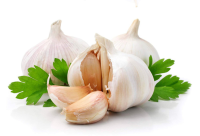Garlic
 Despite its strong odor, garlic has been mentioned for centuries as a folk remedy. The odor, from sulfur gas, is the component which accounts for the theory that this herb can repel evil spirits. Perhaps for this reason, garlic has been called "the king of herbs."
Despite its strong odor, garlic has been mentioned for centuries as a folk remedy. The odor, from sulfur gas, is the component which accounts for the theory that this herb can repel evil spirits. Perhaps for this reason, garlic has been called "the king of herbs."
Overview
Garlic has been used for treating medical conditions and has also been known as the "poor person's antibiotic." Garlic is a bulb made up of separate cloves, each of which could become the seed for a future plant. This herb can be used for preventing heart disease and stroke, reducing the risk of stomach and colon cancers, easing ear infections and lowering triglycerides and cholesterol.
History
This strong-smelling herb is known to be one of the oldest cultivated plants in the world and is native to Central Asia. Documents written in sanskrit record the use of garlic remedies some 5,000 yeas ago, and the Chinese have been utilizing garlic for at least 3,000 years. An Egyptian medical papyrus called the Ebers Codex dates back to around 1550 B.C.E. and talks about garlic as an effective treatment for several ailments.
Pliny, Aristotle and Hippocrates all cited a number of therapeutic uses for garlic. Some of the conditions garlic has been used to treat include coughs, dandruff, atheroschlerosis, earache, diarrhea, hypertension, diptheria, hysteria, dysentery, toothache, vaginitis and others.
In today's world, the top commercial producers of garlic are South Korea, China, India, Spain and the United States.
Nutritional Information
Garlic is a very good source of vitamin B6. In addition, it is a good source of selenium, manganese and vitamin C. Garlic also provides other minerals, including calcium, phosphorous, copper and iron.
A 100-gram serving holds 149 calories, 6.4 grams of protein, 33.1 grams of carbohydrates, 0.5 gram of fat and 2.1 grams of fiber.
Health Benefits
The health-giving properties attributed to this herb are almost too numerous to mention. Several of the therapeutic effects of garlic are thought to be due to its volatile factors, which are composed of the sulfur-containing compounds diallyl disulfide, allicin, diallyl trisulfide and others. Trace minerals are also found in garlic, as well as glucosinolates and enzymes. When garlic is chopped or crushed it stimulates the enzymatic process that converts the phytochemical alliin.
Although further studies are needed, this herb appears to provide protection against heart disease and atherosclerosis. Studies have shown garlic thins the blood and lowers cholesterol, which may be helpful in preventing stroke and heart disease.
Garlic has also shown an ability to lower blood pressure in many studies. It typically decreases the systolic pressure by around 8 mm Hg and diastolic pressure by 5 mm Hg in patients with high blood pressure.
This herb also has long been used an infection fighter. The antimicrobial activity in garlic is due to its allicin content. Allicin has not only been shown to be effective against common infections such as flu, colds and stomach viruses, but is also beneficial when used against powerful pathogenic microbes including botulism and tuberculosis.
In a study at Boston City Hospital, garlic was used to successfully kill 14 strains of bacteria taken from the throats and noses of children with ear infections.
Garlic also appears to be useful as protection against some cancers. Research has shown that as little as two or more servings of garlic per week may help protect against colon cancer. Some of the substances such as allicin in garlic not only protect colon cells from the toxic effects of cancer-causing chemicals, but also aid in stopping the growth of cancer cells once they develop in the body.
Researchers have noted that the people who are native to Southern Italy eat a lot of garlic and develop less stomach cancer than the nongarlic-eaters in Northern Italy.
Safety
Garlic has very few safety issues. Allergies to this herb are rare.
Selecting and Storing
Fresh garlic should be purchased for maximum flavor and health benefits. The cloves should be plump, with unbroken skin. Garlic that is soft, mildewy or darkening should not be purchased. Garlic which is in a paste, flakes or powder may be convenient but hold little benefit as nutrients.
Fresh garlic should be stored at room temperature in a loosely covered (or uncovered) container in a cool and dry place. If garlic is stored in this manner it helps prevent sprouting. Whole garlic bulbs usually store well for anywhere from two weeks to two months.
Serving Ideas for Garlic
Garlic can be used chopped, crushed or sliced. This herb can be used as follows:
- Added to foods, sauces and soups.
- Macerated in olive oil for one week and used in dressings and marinades.
- Pureed and added to 12 ounces of canned garbanzo beans, 2 tablespoons sesame butter, 2 tablespoons olive oil and 2 to 3 tablespoons lemon juice for a simple hummus dip.
- Chopped and stuffed into pitted olives.
References
- Holford, P.(2004). The optimum nutrition bible. London : Piatkus
- Holford, P & Lawson, S. (2008). Optimum Nutrition Made Easy How to achieve optimum health. London : Piatkus
- Murray, M.T. et al.(2005). Encyclopedia of healing foods. London : Piatkus
- Yeager, S. & Prevention Health Books. (1998). The doctors book of food remedies : the newest discoveries in the power of food to cure and prevent health problems from aging and diabetes to ulcers and yeast infections. [Emmaus, Pa.] : Rodale
Posted in Garlic
Ask a Question Or Join a Discussion


